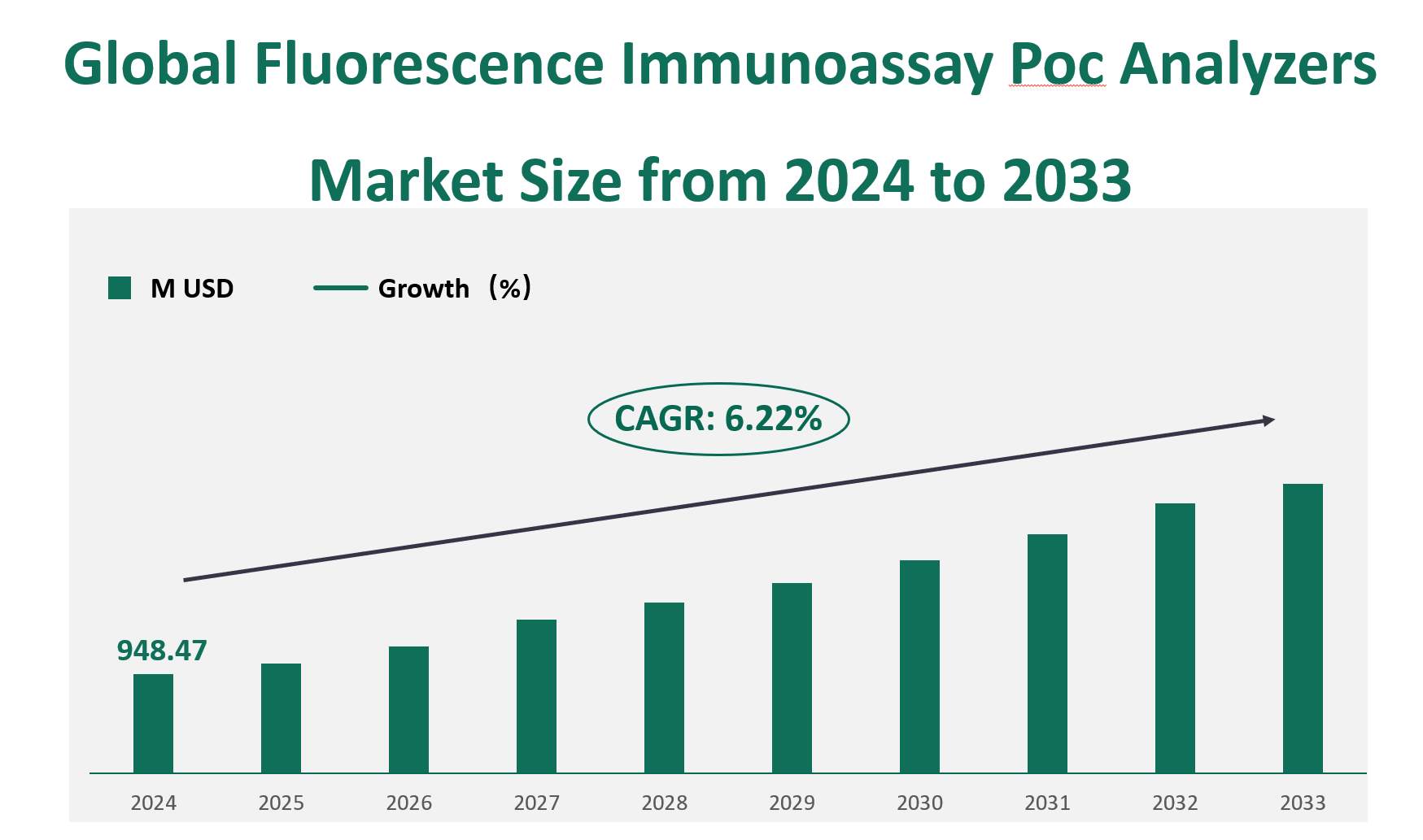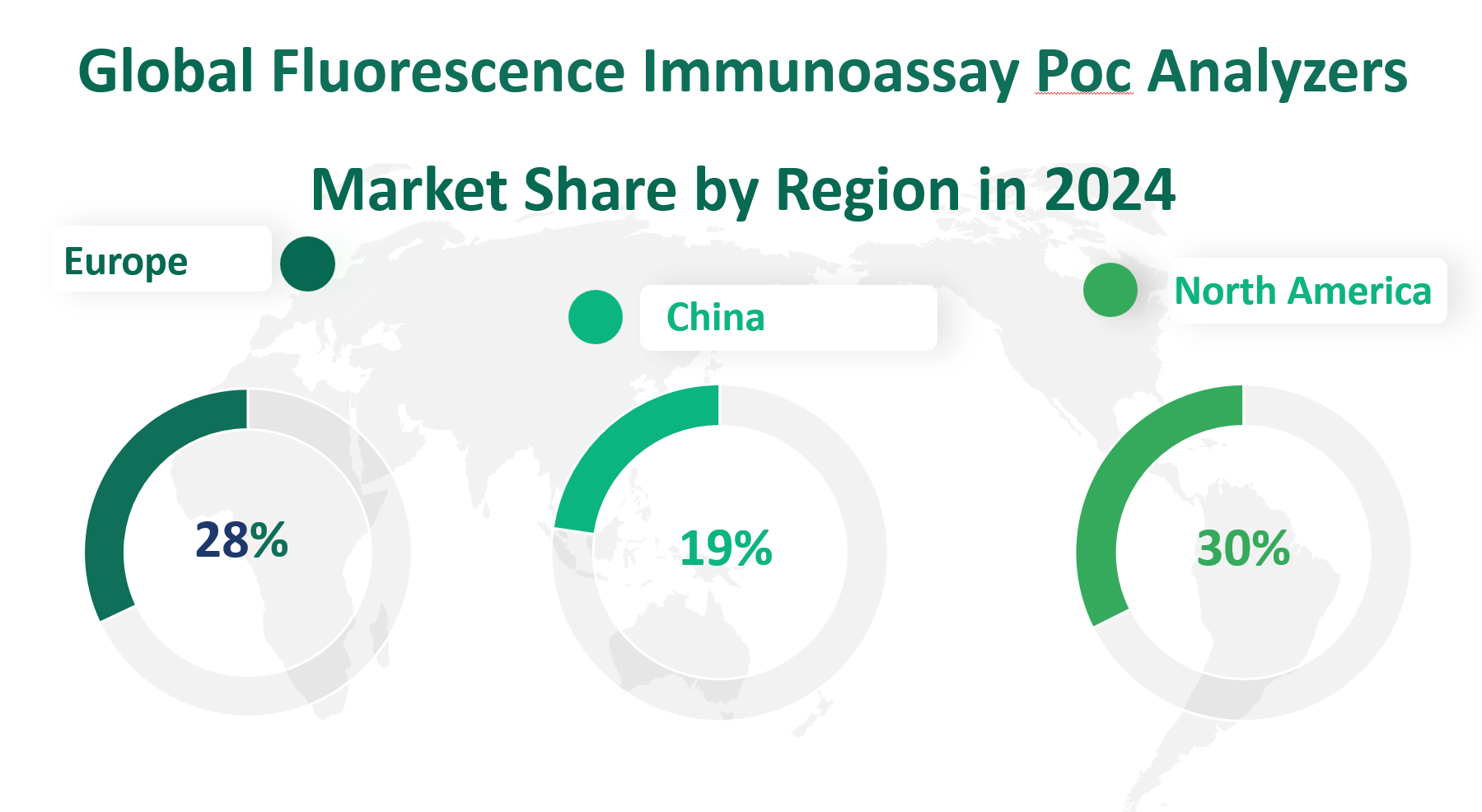1. Global Fluorescence Immunoassay Poc Analyzers Market Outlook
The global Fluorescence Immunoassay Poc Analyzers market revenue is projected to reach 948.47 million USD in 2024, with a Compound Annual Growth Rate (CAGR) of 6.22% anticipated from 2024 to 2033.
Fluorescence Immunoassay Poc Analyzers are sophisticated diagnostic tools that leverage the principles of fluorescence detection during antigen-antibody interactions. These analyzers are designed for in vitro diagnostic use, particularly in point-of-care settings such as outpatient departments, emergency units, community health centers, and medical centers. They offer the advantage of high accuracy, stability, and rapid results, making them invaluable in clinical settings where quick and reliable diagnostic information is crucial.
Figure Global Fluorescence Immunoassay Poc Analyzers Market Size (M USD) and CAGR (2024-2033)

2. Driving and Limiting Factors of Fluorescence Immunoassay Poc Analyzers Market Growth
The growth of the Fluorescence Immunoassay Poc Analyzers market is driven by several key factors. Firstly, the increasing demand from downstream patients for these analyzers is a significant driver. As the global population ages, the prevalence of chronic diseases such as heart disease, cancer, diabetes, and infectious diseases rises, necessitating more frequent and accurate diagnostic testing.
Secondly, the convenience of the Internet and the development of e-commerce have revolutionized the way these analyzers are distributed and sold. Online platforms reduce transaction costs, simplify business management, and enhance customer satisfaction through real-time updates and efficient order tracking.
Additionally, active medical equipment policies in various regions, such as the United States and China, have encouraged the development and adoption of these analyzers. For instance, the United States has abolished the consumption tax on medical devices, and China has implemented stricter regulatory policies to enhance the supervision of medical devices, thereby promoting the industry’s growth.
Despite the positive growth drivers, the market faces certain challenges. The government’s regulatory policies, particularly in regions like the European Union and the United States, impose strict requirements on manufacturers. The new IVDR regulation in the EU, for example, has increased the responsibilities and regulatory requirements for POCT manufacturers, potentially affecting their cooperation with existing customers. Furthermore, the industry is characterized by fierce competition, with many companies vying for market share. This competition can lead to price wars and increased marketing efforts, which may strain the resources of smaller players.
Additionally, the development of new products in the POCT industry requires significant investment, long R&D cycles, and high risks. Companies may face technological deviations, unexpected R&D processes, or failure to register products in a timely manner, which can hinder their product iteration and market competitiveness.
3. Technology Innovation and Corporate Mergers and Acquisitions in Fluorescence Immunoassay Poc Analyzers Market
Technological innovation plays a pivotal role in the growth of the Fluorescence Immunoassay Poc Analyzers market. Continuous advancements in detection technologies, such as the use of advanced fluorescent reagents and more sensitive optical sensors, have improved the accuracy and speed of these analyzers. Moreover, the integration of Internet of Things (IoT) technology has enabled remote monitoring and data sharing, enhancing the efficiency of diagnostic processes.
In terms of corporate activities, mergers and acquisitions have been strategic moves to strengthen market positions. For example, bioMérieux’s acquisition of a majority stake in Hybiome has bolstered its presence in the immunoassay market, particularly in China. Similarly, Siemens Healthineers’ acquisition of Varian has created a highly integrated portfolio of imaging, laboratory diagnostics, artificial intelligence, and treatment solutions, positioning the combined company as a strong player in the global fight against cancer. These strategic moves not only enhance the product offerings of the acquiring companies but also contribute to the overall growth and consolidation of the market.
4. Global Fluorescence Immunoassay Poc Analyzers Market Size by Type
The Fluorescence Immunoassay Poc Analyzers market is segmented into two primary product types: Portable POC Analyzers and Non-Portable POC Analyzers.
Portable POC Analyzers are designed to be lightweight, easy to use, and adaptable to various laboratory environments, including point-of-care facilities. They offer the advantage of flexibility and portability, allowing for molecular detection, such as virus and sexually transmitted diseases detection, to be performed closer to patient care settings. This not only simplifies testing procedures but also provides an opportunity to transfer tests from licensed medical technicians to healthcare professionals closer to the patients or even to the patients themselves in some cases.
In contrast, Non-Portable POC Analyzers are used when Portable POC Analyzers are not available. They are typically larger and more complex, but they offer advanced features and capabilities that may not be present in portable versions. These analyzers are often used in more controlled and specialized laboratory settings where space and resources are not as limited.
In terms of market revenue, the report forecasts that in 2024, the Portable POC Analyzers market will generate $439.46 million, while the Non-Portable POC Analyzers market will reach $509.01 million. The Non-Portable POC Analyzers currently hold a larger market share, but the Portable POC Analyzers are growing at a faster rate.
Table Global Fluorescence Immunoassay Poc Analyzers Market Size by Type in 2024
5. Global Fluorescence Immunoassay Poc Analyzers Market Size by Application
The applications of Fluorescence Immunoassay Poc Analyzers span across several sectors, with the primary ones being Medical, Veterinary, and Other applications.
The Medical application involves the use of these analyzers in ordinary hospitals and clinics for the diagnosis of human patients. This sector is the largest consumer of Fluorescence Immunoassay Poc Analyzers due to the high demand for accurate and timely diagnostic results in healthcare settings.
The Veterinary application pertains to animal hospitals and clinics, where these analyzers are used for diagnosing and monitoring the health of animals.
In 2024, the Medical application is projected to have the largest market revenue, reaching $649.51 million. This significant share is a reflection of the critical role that Fluorescence Immunoassay Poc Analyzers play in human healthcare. The rapid diagnosis of diseases and conditions in medical settings is essential for effective treatment and patient management, driving the high demand for these analyzers in the medical field.
The Veterinary application, while smaller in comparison, is also a notable market segment, with an estimated revenue of $205.06 million in 2024. The growth in this sector is driven by the increasing importance of animal health and the need for advanced diagnostic tools in veterinary medicine. As pet ownership continues to rise and the livestock industry demands more sophisticated health monitoring, the market for Fluorescence Immunoassay Poc Analyzers in veterinary applications is expected to grow steadily.
Table Global Fluorescence Immunoassay Poc Analyzers Market Size by Application in 2024
Application | Market Size (M USD) 2024 |
Medical | 649.51 |
Veterinary | 205.06 |
Other | 93.90 |
6. Major Region of Fluorescence Immunoassay Poc Analyzers Market
North America led the way with a consumption of 52.17 K Units, followed closely by Europe with 48.26 K Units. China, with a consumption of 33.74 K Units, demonstrated a significant market presence, while Japan, the Middle East and Africa, South America, India, South Korea, and Southeast Asia contributed 6.91 K Units, 5.59 K Units, 4.43 K Units, 6.96 K Units, 3.44 K Units, and 5.85 K Units, respectively.
Analyzing the market sales, North America emerged as the largest market with a share of 30%. Europe followed with a revenue of 259.48 M USD, holding a 28% market share. China has a market share of 19%, indicating its growing importance in the global market.
Figure Global Fluorescence Immunoassay Poc Analyzers Market Size by Region in 2024

7. Global Fluorescence Immunoassay Poc Analyzers Market Analysis by Major Players
7.1 Siemens
Company Introduction and Business Overview: Siemens, established in 1847, is a global leader in medical technology. The company is headquartered in Erlangen, Germany, and operates primarily in Europe. Siemens Healthineers aims to increase value for healthcare providers by expanding precision medicine, transforming care delivery, improving patient experience, and digitalizing healthcare. The company’s business encompasses diagnostic and therapeutic imaging, laboratory diagnostics, and molecular medicine.
Products Offered: Siemens offers a range of Fluorescence Immunoassay Poc Analyzers, including the Stratus® CS 200 Acute Care™ Troponin Analyzer, which provides quantitative cardiac assays for fast and accurate evaluation of patients with suspected myocardial ischemia.
Sales Revenue in 2021: In 2021, Siemens generated a revenue of 124.50 M USD from its Fluorescence Immunoassay Poc Analyzers, holding a market share of 15.83%.
7.2 Quidel
Company Introduction and Business Overview: Quidel Corporation, founded in 1979, is a leading diagnostic healthcare manufacturer based in San Diego, California. The company focuses on developing diagnostic solutions that improve patient outcomes and provide economic benefits to the healthcare system. Quidel’s products span from advanced lateral-flow and direct fluorescent antibody tests to molecular diagnostic tests.
Products Offered: Quidel’s Sofia Fluorescent Immunoassay Analyzer is a small bench-top device that uses advanced fluorescence detection with an ultraviolet LED energy source. It offers an easy-to-use interface and customizable settings, making it suitable for point-of-care testing.
Sales Revenue in 2021: Quidel’s revenue from Fluorescence Immunoassay Poc Analyzers in 2021 was 91.10 M USD, with a market share of 11.58%.
7.3 BioMérieux
Company Introduction and Business Overview: BioMérieux, established in 1963, is a French multinational biotechnology company headquartered in Marcy-l’Étoile, France. The company provides diagnostic solutions that determine the source of disease and contamination to improve patient health and ensure consumer safety. Its products are used for diagnosing infectious diseases, cancer screening, and monitoring cardiovascular emergencies.
Products Offered: BioMérieux’s MINI VIDAS® is a compact automated immunoassay system based on Enzyme Linked Fluorescent Assay (ELFA) principles. It is designed for on-demand testing and offers a broad menu of over 100 parameters.
Sales Revenue in 2021: BioMérieux’s revenue from Fluorescence Immunoassay Poc Analyzers in 2021 was 88.45 M USD, holding a market share of 11.25%.

